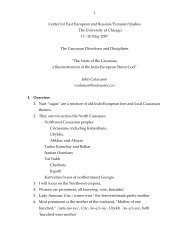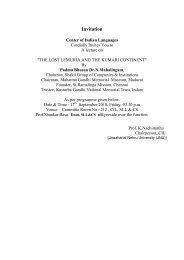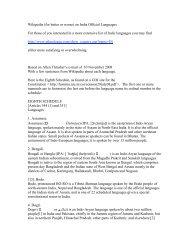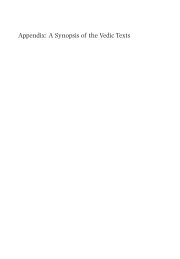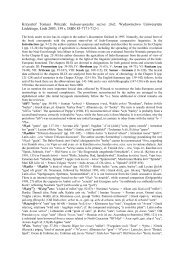tamgas or tamghas; cf. Scandinavian bumerker
tamgas or tamghas; cf. Scandinavian bumerker
tamgas or tamghas; cf. Scandinavian bumerker
Create successful ePaper yourself
Turn your PDF publications into a flip-book with our unique Google optimized e-Paper software.
One ancient heraldic-type system developed around clan, tribe, <strong>or</strong> household marks (<strong>tamgas</strong><br />
<strong>or</strong> <strong>tamghas</strong>; <strong>cf</strong>. <strong>Scandinavian</strong> <strong>bumerker</strong>) found throughout the Old W<strong>or</strong>ld from pre-literate<br />
to modern times. Left: Shahdad tamga-like signs (over 300 known), contemp<strong>or</strong>ary with<br />
Indus symbols. Right, examples some 3000 years later from Sarkel (N. Black Sea). Note how<br />
several of the latter are joined in ‘composite’ <strong>tamgas</strong>.<br />
Right: ‘Modern’ Mongolian tamagas<br />
(h<strong>or</strong>se brands, clan marks, mystical<br />
signs. Their extra<strong>or</strong>dinarily complex<br />
syntax is unraveled in Waddington 1974)
Things were added and subtracted in <strong>tamgas</strong> to distinguish fathers and son <strong>or</strong> to<br />
mark social alliances <strong>or</strong> marriages, etc.—much as in Western heraldry. Multisign<br />
<strong>tamgas</strong> were also f<strong>or</strong>med at times to mark social <strong>or</strong> political compacts.<br />
Suggestions of similar processes show up in late Indus inscriptions, which<br />
sometimes seem to combine in a kind of ‘cartouche’ principle .<br />
England Alone<br />
Tamgas of four Bosp<strong>or</strong>an kings<br />
(Ol’hovskij 2001, after Solomonik 1959)<br />
England + Scotland<br />
+ Ireland = United<br />
Kingdom<br />
United Kingdom as<br />
viewed from<br />
Scotland
Mauryan and post-Mauryan symbols (many hundreds known<br />
on punch-marked coins, stelae, pillars, plates, columns, etc.)<br />
Some of the 400-600<br />
known Mauryan symbols<br />
Mauryan punch-marked coins<br />
Mauryan Sohgaura<br />
plate (<strong>cf</strong>. Fleet 1907,<br />
Allchin 1959, etc.)<br />
Silver coin of the Kuninda<br />
Kingdom, c. 1st century BCE.<br />
carrying earlier Mauryan symbols.<br />
Obverse carries symbols<br />
surrounded by a Brahmi prakrit<br />
legend. Inverse carries symbols<br />
surrounded by Kharosthi.
Mesopotamian ‘multivocal’ signs (stand f<strong>or</strong> gods, families, clans, celestial bodies,<br />
etc.) — ubiquitous on plaques, stelae, seals, etc. We currently picture the Indus<br />
system as something of a cross between these and ‘<strong>tamgas</strong>’, but also with its own<br />
peculiarities. All these are similar in the sense that (unlike, say, proto-cuneif<strong>or</strong>m<br />
<strong>or</strong> Naxi mnemonic texts) they don’t encode long serial ‘messages’.



